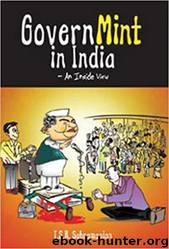Goverment In India by T. S. R. Subramanian

Author:T. S. R. Subramanian [Subramanian, T. S. R.]
Language: eng
Format: epub
Publisher: Rupa & Co
Published: 2009-04-30T18:30:00+00:00
6
THE PRESIDENCY
t is said that the president 'reigns, but does not rule'. Corresponding to this saying, the Indian Constitution envisages the president to be the republic's titular head. Drawn on the British parliamentary democracy model as it existed in the mid-twentieth century, the Indian president corresponds to the British monarch, in terms of the role played, functions discharged and in the overall conception. All appointments to constitutional positions in the country and to the All India Services are made by the president nominally. Similarly, the president is also the commander-in-chief of the Armed Forces, in a titular, though symbolic manner. However, it is the government of the day which processes and makes the appointments, without the specific concurrence of the president for each instance. There are also some positions for which the explicit prior consent of the president is taken, but whatever the case may be, the appointment is actually made by the government, in the name of the president.
Between 1947, when India became independent, and 1950, when India became a republic, the head of state was designated as the governor general. The last viceroy during British rule in India, Lord Mountbatten, became the first governor general of independent India; this was a remarkable expression of goodwill between the erstwhile rulers and its colony. However, here too, the governor general was only a titular head of state, while Pandit Jawaharlal Nehru headed the first Indian Cabinet of independent India. State power had been transferred by the British to the Indians on 15 August 1947. As is known to everyone, what followed was the infamous Partition of India, and led to what has been called the largest genocide in history. This reminds me of an episode, which is probably not well remembered or noted in India – during the peak of the atrocities that took place in the Punjab and in Bengal, the governor general, in fact, at least on one occasion presided over a 'crisis' meeting of the Cabinet, which had met to take emergency measures; thus, even in independent India, there has been an instance of the titular head of state presiding over a functional Cabinet meeting; clearly an aberration from the parliamentary democratic process. As we would see later in this chapter, the successive presidents of the republic remained mere titular heads, playing arguably even less than the minimal role envisaged by the letter of the Constitution. Chakravarthi Rajagopalachari, Rajaji as he was known, was the first Indian governor general of independent India.
The first president of the republic in 1951 was Dr Rajendra Prasad, a Congress leader who was prominent during the freedom movement. He has been followed, in general, by a succession of fairly eminent persons, mostly from among the political community. Many distinguished persons have held this position, including Sarvepalli Radhakrishnan, Zakir Hussain, and R. Venkataraman, who deserve mention. The only non-political appointee was A.P.J. Abdul Kalam, who was the president till recently. It is interesting to note that while selecting the president, care has been
Download
This site does not store any files on its server. We only index and link to content provided by other sites. Please contact the content providers to delete copyright contents if any and email us, we'll remove relevant links or contents immediately.
| Arms Control | Diplomacy |
| Security | Trades & Tariffs |
| Treaties | African |
| Asian | Australian & Oceanian |
| Canadian | Caribbean & Latin American |
| European | Middle Eastern |
| Russian & Former Soviet Union |
The Secret History by Donna Tartt(18075)
The Social Justice Warrior Handbook by Lisa De Pasquale(11940)
Thirteen Reasons Why by Jay Asher(8414)
This Is How You Lose Her by Junot Diaz(6408)
Weapons of Math Destruction by Cathy O'Neil(5797)
Zero to One by Peter Thiel(5456)
Beartown by Fredrik Backman(5303)
The Myth of the Strong Leader by Archie Brown(5214)
The Fire Next Time by James Baldwin(4997)
How Democracies Die by Steven Levitsky & Daniel Ziblatt(4940)
Promise Me, Dad by Joe Biden(4897)
Stone's Rules by Roger Stone(4829)
100 Deadly Skills by Clint Emerson(4659)
Rise and Kill First by Ronen Bergman(4535)
A Higher Loyalty: Truth, Lies, and Leadership by James Comey(4530)
The David Icke Guide to the Global Conspiracy (and how to end it) by David Icke(4358)
Secrecy World by Jake Bernstein(4354)
The Farm by Tom Rob Smith(4303)
The Doomsday Machine by Daniel Ellsberg(4230)
